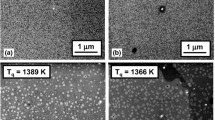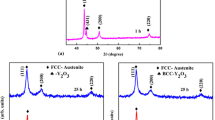The distribution of doping elements and impurities between the external surfaces and internal volumes of typical fine particles in samples of gas-atomized commercial additive powders of hightemperature creep-resistant (Inconel 939, ZhS32) and high-temperature oxidation-resistant (Inconel 625, Hastelloy C22) nickel superalloys was examined employing energy-dispersive X-ray analysis (EDX). Significant concentration gradients were observed between the surfaces and internal volumes of powder particles for doping elements reaching 4–5 wt.%: Re, Mo Ta, and Nb in the high-temperature creep-resistant alloys and Al, Nb, Co, Fe, V, and Mn in the Inconel 625 hightemperature oxidation-resistant alloy. Besides doping elements, concentration gradients of O, N, S, P, and Si impurities were found in the near-surface layers of the additive powders. The EDX findings and data from the reduction–extraction method were used to calculate the amounts of oxygen and nitrogen in the internal volumes and the near-surface layer of typical fine powder particles and the thickness of this layer corresponding to the increased content of impurities. The surface layer of typical fine particles was shown to increase the total weight-average content of impurities in the samples of commercial additive powders: oxygen up to 2.5 times and nitrogen up to 1.8 times. To assess the influence of impurity amounts of oxygen <0.16 wt.% and nitrogen <0.13 wt.% on the welding process properties of the atomized additive powders, additional samples of hightemperature oxidation-resistant (ChS40) and high-temperature creep-resistant (ZhS6U, ZhS32, Renè 80) nickel superalloys were tested to ascertain their suitability for microplasma powder deposition at a welding current of up to 15 A. It was found that the suitability of the additive powder for lowamperage deposition was mainly determined by the limited oxygen impurity content: weight-average content up to 0.025 wt.% and content in the 1–3 μm thick near-surface layer of a typical fine particle up to 0.1 wt.%.









Similar content being viewed by others
Notes
In welding terminology, side reinforcements refer to the metal that is deposited in the cross-section of the builtup roller, specifically between the extension of the narrow substrate with width δ and its outer contour (Fig. 3b).
References
I. Gibson, D. Rosen, and B. Stucker, Additive Manufacturing Technologies. 3D Printing, Rapid Prototyping, and Direct Digital Manufacturing, Second Edition, Springer Science+Business Media, New York (2015), p. 498.
Gu Dongdong, Laser Additive Manufacturing of High-Performance Materials, Springer-Verlag, Heidelberg, Berlin (2015), p. 311.
M.A. Zlenko, M.V. Nagaitsev, and V.M. Dovbysh, Additive Manufacturing Technologies in Mechanical Engineering: Manual for Engineers [in Russian], GNTs RF FGUP NAMI, Moscow (2015), p. 220.
H. Wang, W. Jiang, M. Valant, and R. Kovacevic, “Microplasma powder deposition as a new solid freeform fabrication process,” in: Proc. Inst. Mech. Eng. Part B. J. Eng. Manuf., Vol. 217 (2003), pp. 1641–1650, https://doi.org/10.1243/095440503772680578.
V. Korzhyk, V. Khaskin, O. Voitenko, V. Sydorets, and O. Dolianovskaia, “Welding technology in additive manufacturing processes of 3D objects,” Mater. Sci. Forum, 906, 121_130 (2017), https://doi.org/10.4028/www.scientific.net/MSF.906.121.
P.D. Zhemanyuk, I.A. Petrik, and S.L. Chigilejchik, “Experience of introduction of the technology of reconditioning microplasma powder surfacing at repair of high-pressure turbine blades in batch production,” Paton Weld. J., No. 8, 43–46 (2015), https://doi.org/10.15407/tpwj2015.08.08.
K.A. Yushchenko, O.V. Yarovitsyn, O.O. Nakonechnyi, I.R. Volosatov, O.O. Fomakin, and G.D. Khrushchov, “Development of the technology of reconditioning the sealing element of nozzle blade sector from difficult-to-weld high-temperature nickel alloy of ZhS6 type by microplasma powder surfacing,” Paton Weld. J., No. 11, 25–28 (2020), https://doi.org/10.37434/tpwj2020.11.05.
S.L. Chigileichik, I.A. Petrik, O.V. Ovchinnikov, and S.V. Kirilakha, “Experience in implementation of additive manufacturing techniques for repair of gas turbine engine parts from the EP-648 VI (KhN50VMTYuB-VI) alloy in commercial production conditions,” Aviat. Kosm. Tekh. Tekhnol., No. 1(177), 57–60 (2022), https://doi.org/10.32620/aktt.2022.1.07.
K.A. Yushchenko and A.V. Yarovitsyn, “Influence of active gas content and disperse filler continuity on the process bead formation in microplasma powder surfacing of nickel superalloys,” Paton Weld. J., No. 6–7, 115–123 (2014), https://doi.org/10.15407/tpwj2014.06.25.
S.V. Nerush, A.S. Ermolaev, A.M. Rogalev, and S.A. Vasilenko, “Studying the process for restoring the edges of first-stage blade airfoils in high-pressure turbine (HPTs) from the ZhS32-VI alloy by laser powder deposition using atomized ZhS32-VI alloy metal powder,” Elektron. Nauch. Zh. Trudy VIAM, No. 8(44), 24–34 (2016), https://doi.org/10.18577/2307-6046-2016-0-8-4-4.
K.A. Yuschenko, O.V. Yarovytsyn, H.D. Khruschov, I.A. Petryk, and S.L. Chyhileychic, “Understanding the impact of oxygen and nitrogen content in metal powder on microplasma multilayers deposition of aircraft GTE blade edges,” in: Proc. 9th Int. Conf. Young Scientist on Welding and Related Technologies, Paton Weld. Inst. Nats. Akad. Nauk Ukrainy (2017), pp. 257–261.
K.A. Yushchenko, O.V. Yarovitsyn, G.D. Khrushchov, I.A. Petrik, and S.L. Chigileichik, “Study and optimization of commercial maintenance of operating blades of D-18T aviation gas turbine engines using microplasma powder deposition,” Kosm. Nauka Tekhnol., 28, No. 3, 3–16 (2022), https://doi.org/10.15407/knit2022.03.003.
P.V. Gladkii, E.F. Perepletchikov, and I.A. Ryabtsev, Plasma Deposition [in Russian], Ekotekhnologia, Kyiv (2007), p. 292.
O.V. Yarovitsyn and A.V. Mikitchik, “Requirements for boundary relative content of oxygen and nitrogen impurities in near-surface layers of the additive ZhS32 powder for microplasma deposition,” Metallofiz. Noveish. Technol., No. 4(43), 519–540 (2021), https://doi.org/10.15407/mfint.43.04.0519.
ISO 4491-4:2013(E). Metallic Powders—Determination of Oxygen Content Reduction Methods. Part 4: Total Oxygen by Reduction–Extraction, ISO copyright office (2013), p. 12.
ASTME E1019-11. Standard Test Methods for Determination of Carbon, Sulfur, Nitrogen, and Oxygen in Steel, Iron, Nickel, and Cobalt Alloys by Various Combustion and Fusion Techniques, ASTM Int. (2011), p. 24.
ISO 22309:2011(en). Microbeam Analysis—Quantitative Analysis Using Energy-Dispersive Spectrometry (EDS) for Elements with an Atomic Number of 11 (Na) or Above, ISO copyright office (2011), p. 22.
E.N. Kablov, Cast Blades of Gas Turbine Engines: Alloys and Coating Techniques [in Russian], 2nd ed., Nauka, Moscow (2006), p. 632.
EN ISO 14175-2008. Welding Consumables—Gases and Gas Mixtures for Fusion Welding and Allied Processes, ISO copyright office (2008), p. 14.
EN ISO 4490:2018. Metallic Powders—Determination of Flow Rate by Means of a Calibrated Funnel (Hall Flowmeter), ISO copyright office (2018), p. 7.
V.P. Kuznetsov, V.P. Lesnikov, and I.P. Konakova, Structure and Properties of the High-Temperature Creep-Resistant ZhS32-Vi Alloy: Handbook [in Russian], Kvist, Ekaterinburg (2010), p. 84.
M.R. Jahangiri, H. Arabi, and S.M.A. Boutorabi, “Comparison of microstructural stability of IN939 superalloy with two different manufacturing routes during long-time aging,” Trans. Nonferrous Met. Soc. China, 24, 1717–1729 (2014), https://doi.org/https://doi.org/10.1016/S1003-6326(14)63245-3.
A.F. Belyavin, V.V. Kurenkova, I.S. Malashenko, V.V. Grabin, V.V. Trokhimchenko, and L.V. Chervyakova, “Strength and microstructure of brazed joints of the ZhS6U alloy produced using boron- and boron–silicon-containing fillers,” Sovr. Elektrometall., No. 2, 40–52 (2010).
M.V. Khanapetov, Welding of Structures with Complementary Powder Additive [in Russian], Stroiizdat, Moscow (1992), p. 192.
M. Kalinyuk, S. Isakova, and L. Puzyrina, “Analyzing metal powders for oxygen, nitrogen, and hydrogen impurity contents,” Metrol. Pryl., No. 5, 62–69 (2019), https://doi.org/10.33955/2307-2180(5)2019.62-69.
O.V. Yarovitsyn, “Assessing the deformation capability of deposited metal of high-temperature creepresistant alloy with high content of the γ′ phase,” Metalloznav. Obrob. Met., 26(94), 38–48 (2020), https://doi.org/10.15407/mom2020.02.38.
Author information
Authors and Affiliations
Corresponding author
Additional information
Translated from Poroshkova Metallurgiya, Vol. 62, Nos. 5–6 (551), pp. 16–36, 2023
Rights and permissions
Springer Nature or its licensor (e.g. a society or other partner) holds exclusive rights to this article under a publishing agreement with the author(s) or other rightsholder(s); author self-archiving of the accepted manuscript version of this article is solely governed by the terms of such publishing agreement and applicable law.
About this article
Cite this article
Yarovytsyn, O.V., Mykytchyk, A.V. & Oliynyk, Y.V. New Process Requirements for Additive Powders for Microplasma Powder Deposition. Powder Metall Met Ceram 62, 276–292 (2023). https://doi.org/10.1007/s11106-023-00392-3
Received:
Published:
Issue Date:
DOI: https://doi.org/10.1007/s11106-023-00392-3
Keywords
- high-temperature creep-resistant and oxidation-resistant nickel superalloys
- additive powders
- EDX analysis
- distribution of doping elements and impurities
- surface layer and crosssection of a typical fine powder particle
- microplasma powder deposition
- process testing of additive powders
- weight-average oxygen and nitrogen content




